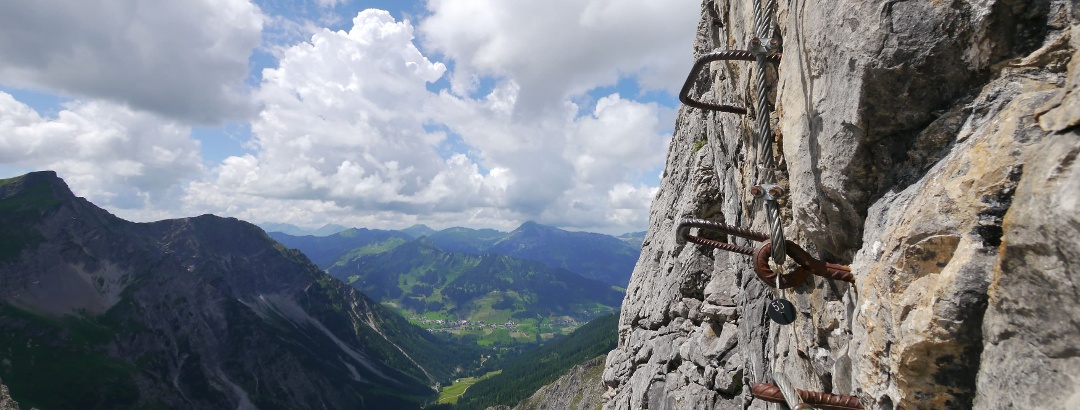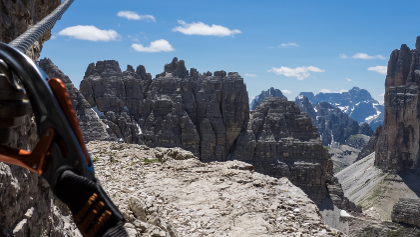Via Ferrata
Via Ferratas offer experienced hikers and those interested in climbing a relatively safe entry into the world of walls, ridges and rocks. Anyone who is familiar with carabiners, has arm strength, a head for heights and a dose of courage can dare to climb spectacular areas that are often breakneck exposed and breathtakingly steep. Find the right via ferrata for you with Outdooractive!
The best regions
What is a Via Ferrata?
The Italian name "Via Ferrata" - in English "iron path" - already reveals what it's all about on via ferratas: steep paths through alpine terrain and directly on rock faces secured with steel ropes, iron steps, stairs, clamps and ladders. Unlike alpine climbing, the route on the via ferrata is pre-determined.
Incidentally, the first via ferrata to be used for tourism was built on the Dachstein in Austria in 1843. It had iron pins, steps chiseled into the rock and even a ship's rope as a safety rope. However, short connecting routes with wooden ladders and laid-out footholds existed in the mountains centuries earlier.
Today there are different types of via ferrata, which vary in difficulty:
- Secured trails in alpine terrain are more demanding than difficult hiking trails, but can often be climbed by sure-footed and experienced mountaineers without the need for a belay.
- Classic alpine via ferratas lead directly on the rock to summits or over ridges and require not only complete equipment (see below) but also mountain and climbing experience, a good sense of direction and good physical condition and endurance.
- Sport via ferratas are the right choice for those who want to improve their climbing technique and really get out there: With difficult routes and exciting elements such as rope bridges, Nepal bridges, ladders or flying foxes, the focus here is more on athletic performance than on experiencing nature.
Since via ferratas are becoming increasingly popular, numerous new facilities are being built in the Alpine region. Children, too, have the opportunity to climb steep rocks in via ferrata routes specially built for them - provided, of course, that they are appropriately well secured.
Recommended routes: Your Via Ferrata adventure!
If you want to climb a via ferrata for the first time, it is best to start with a short and easy climb and then increase with every route. This also applies, by the way, if you have already gained climbing experience in the climbing hall! Many newcomers overestimate themselves when they switch from the indoor gym to the real rock in the great outdoors. Guided via ferrata tours are highly recommended, because a mountain guide provides valuable tips and assistance.
With Outdooractive you will find numerous via ferratas in every level of difficulty.
Overview: Via Ferrata difficulty scale
Good planning is the be-all and end-all when it comes to via ferrata. The first step, of course, is to choose a via ferrata that suits your own skill level. In order to make it easier to compare and assess via ferratas, several difficulty scales have been established in the Alpine region. At Outdooractive, we use the Schall scale, which is very common in the Eastern Alps. An overview of the difficulties:
A = easy: flat to steep, mostly rocky or interspersed with rocks, exposed passages possible
B = moderately difficult: steeper rocky terrain, partly small footholds, with exposed passages
C = difficult: steep to very steep rocky terrain, mostly small footholds, longer or very often exposed passages
D = very difficult: vertical, often overhanging terrain; mostly very exposed
E = extremely difficult: vertical to overhanging; exposed throughout; very small footholds or friction climbing
F = more than extremely difficult: primarily overhanging; exposed; very small footholds or friction climbing
On this overview graphic (in German) of the Club Arc Alpin and the German Alpine Club the Schall scale is compared with other difficulty scales. You can also find the graphic in the web version of Outdooractive for each via ferrata route. Just click on the info "i" next to the difficulty in the "Details" tab.
Which equipment do I need for a via ferrata?
Safety is the top priority on any via ferrata. Therefore, you need special equipment in addition to your normal hiking equipment. Be sure to get advice from a specialist store or rental company before your first climb! You have to bring:
- Climbing harness
- Via ferrata set with shock absorber
- Climbing helmet
- First aid kit
- Via ferrata gloves
- Additional safety rope for children and beginners, if necessary
- Lanyard and HMS carabiner if necessary
Modern via ferrata sets have a so-called Y-shape. They consist of two separate branches with elastic and carabiners, as well as a central band fall arrester. The double belay means that the climber is hooked into the steel rope with at least one belay at all times when used correctly. If a fall occurs during the climb, the band fall arrester stops the climber's fall and can save their life.
The via ferrata set is attached to the waist belt's tie-in loop with a sack stitch. In addition to using a hip belt alone, it is also advisable to secure it with a chest harness - which must be connected to the hip belt by means of a hose strap. Uncontrolled falls in the supine position and injuries to the back of the head and spine can thus be significantly reduced.
Via Ferratas with the features of Outdooractive
Offers and discounts from our partners
Benefit from exclusive offers from our partners
As a Pro and Pro+ member not only do you have access to additional features and the best maps at your disposal, but you can also benefit from exclusive offers from our partners, ensuring you are always fully equipped for the outdoors!
Explore all benefits and discounts
